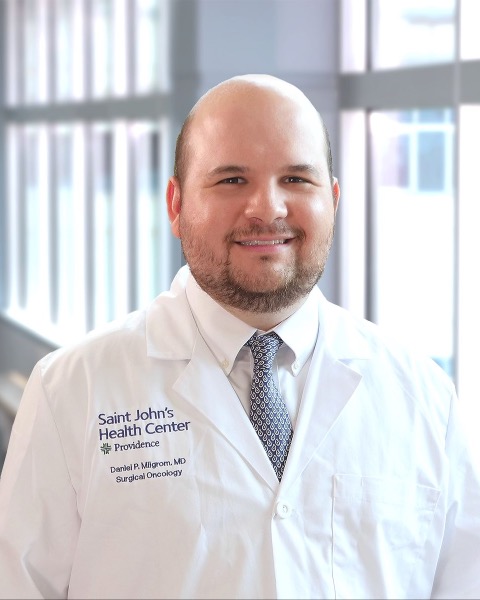Back
Breast
Session: Breast Virtual Poster Grand Rounds
V2: Breast Cancer Diagnosis and Treatment During the covid-19 Pandemic: a Health System’s Experience
Tuesday, March 1, 2022
6:01 PM – 6:04 PM CST
Location: Zoom Meeting

Daniel Milgrom, MD MS
Surgical Oncology Fellow
Providence Saint John's Cancer Institute, United StatesDisclosure: Disclosure information not submitted.
Virtual Poster Presenter(s)
Participants should be aware of the following financial/non-financial relationships:
Daniel Milgrom, MD MS: Disclosure information not submitted.
Introduction: State guidelines to address the Covid-19 pandemic interrupted standard diagnosis and treatment for breast cancer. Reduced screening, competing resource needs, and patients’ avoidance of health care settings characterize the peri-lockdown period. This study characterizes the effect of the pandemic on breast cancer care.
Methods: Within the data warehouse of a large, Midwestern health care system, we identified trends in screening mammography. We also identified 2 cohorts of patients newly diagnosed with any stage of breast cancer during the Lockdown (LD) from 3/23-5/3/2020 and reopening (RO) from 5/4-6/14/2020. Two comparison cohorts were similarly identified in the corresponding periods a year before and after: pre-lockdown (preLD) from 3/25-6/16/2019, and post-lockdown (postLD) from 3/22-6/13/2021. A retrospective analysis was performed of breast cancer screening, diagnosis, and surgical treatment.
Results: Mean weekly counts (standard error [se]) during the preLD, LD, RO, and postLD periods were, respectively, 2287.9 (47.8), 84.5 (9.2), 1442.3 (38.0), and 1985.7 (44.6) for screening mammograms; 20.0 (4.5), 13.2 (3.6), 11.3 (3.4) and 22.0 (4.7) diagnoses of any stage of breast cancer; 3.1 (1.8), 2.2 (1.5), 1.2 (1.1), and 5.0 (2.2) for diagnoses of DCIS; and 10.5 (3.2), 7.7 (2.8), 7.8 (2.8) and 14.8 (3.8) for surgeries. The percent of DCIS (se) per all stages of breast cancer was 15.4 (2.3)% in the preLD compared to 16.5 (4.2)%, 10.3 (3.7)%, and 22.7 (2.6)% in the LD, RO, and postLD groups respectively. Kaplan-Meier survival cures demonstrated a median time-to-surgery (TTS, months) in the preLD group of 1.8 (1.4-4.6, 95% CI), compared to 5.0 (2.0-6.0), 4.4 (1.4-5.5), and 1.6 (1.4 -1.9) in the LD, RO, and postLD groups respectively.
Conclusions: Screening was decreased by over 27-fold during the LD and over 1.5-fold during the RO and continued to be lower in the postLD than the preLD. There were fewer diagnoses of any stage cancer in the RO, which correlates with a decrease in screening during the LD. The postLD group had a higher proportion of DCIS than other cohorts and a shorter TTS than the preLD. This may represent a “catch-up” period for patients who delayed screening due to the pandemic.
Methods: Within the data warehouse of a large, Midwestern health care system, we identified trends in screening mammography. We also identified 2 cohorts of patients newly diagnosed with any stage of breast cancer during the Lockdown (LD) from 3/23-5/3/2020 and reopening (RO) from 5/4-6/14/2020. Two comparison cohorts were similarly identified in the corresponding periods a year before and after: pre-lockdown (preLD) from 3/25-6/16/2019, and post-lockdown (postLD) from 3/22-6/13/2021. A retrospective analysis was performed of breast cancer screening, diagnosis, and surgical treatment.
Results: Mean weekly counts (standard error [se]) during the preLD, LD, RO, and postLD periods were, respectively, 2287.9 (47.8), 84.5 (9.2), 1442.3 (38.0), and 1985.7 (44.6) for screening mammograms; 20.0 (4.5), 13.2 (3.6), 11.3 (3.4) and 22.0 (4.7) diagnoses of any stage of breast cancer; 3.1 (1.8), 2.2 (1.5), 1.2 (1.1), and 5.0 (2.2) for diagnoses of DCIS; and 10.5 (3.2), 7.7 (2.8), 7.8 (2.8) and 14.8 (3.8) for surgeries. The percent of DCIS (se) per all stages of breast cancer was 15.4 (2.3)% in the preLD compared to 16.5 (4.2)%, 10.3 (3.7)%, and 22.7 (2.6)% in the LD, RO, and postLD groups respectively. Kaplan-Meier survival cures demonstrated a median time-to-surgery (TTS, months) in the preLD group of 1.8 (1.4-4.6, 95% CI), compared to 5.0 (2.0-6.0), 4.4 (1.4-5.5), and 1.6 (1.4 -1.9) in the LD, RO, and postLD groups respectively.
Conclusions: Screening was decreased by over 27-fold during the LD and over 1.5-fold during the RO and continued to be lower in the postLD than the preLD. There were fewer diagnoses of any stage cancer in the RO, which correlates with a decrease in screening during the LD. The postLD group had a higher proportion of DCIS than other cohorts and a shorter TTS than the preLD. This may represent a “catch-up” period for patients who delayed screening due to the pandemic.
Learning Objectives:
- describe the impact the Covid-19 pandemic had on breast cancer care
- describe the difference in the proportion of newly diagnosed patients patients with DCIS to invasive cancer changed during the different phases of the Covid-19 pandemic
- characterize how breast cancer health services changed in response to state and federal regulations during the Covid-19 pandemic
